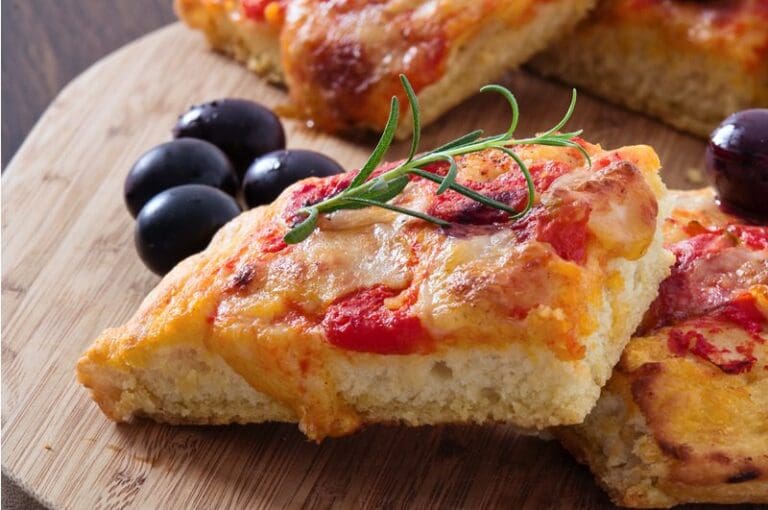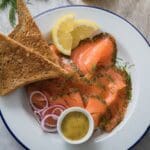I worked with this young chef in Tennessee who has an amazing recipe for just about everything. I mentioned I was trying out some different recipes in the kitchen for focaccia bread, and he turned me onto a unique recipe and methodology that employs Pilsner beer instead of water for the liquid component in the bread.
I am convinced that the use of beer results in a slightly more malty-flavored final product, with a bit more caramelization on the outside crust than when I used the same recipe with water instead of the pilsner beer.
Don’t be afraid by the quantity of olive oil used in this recipe. The olive oil helps provide that lovely golden-brown color and lends richness and flavor to the final bread.

Pilsner Focaccia
I worked with this young chef in Tennessee who has an amazing recipe for just about everything. I mentioned I was trying out some different recipes in the kitchen for focaccia bread, and he turned me onto a unique recipe and methodology that employs Pilsner beer instead of water for the liquid component in the bread. I am convinced that the use of beer results in a slightly more malty-flavored final product, with a bit more caramelization on the outside crust than when I used the same recipe with water instead of the pilsner beer. Don’t be afraid by the quantity of olive oil used in this recipe. The olive oil helps provide that lovely golden-brown color and lends richness and flavor to the final bread.
Ingredients
- 500 grams bread flour
- 375 grams Pilsner of choice
- 7 grams of active dry yeast (1 packet of yeast)
- 10 grams Kosher salt
- 110 grams olive oil (added at various stages)
- Toppings, such as red onions or cherry tomatoes (if desired)
- ½ tsp Maldon finishing salt (for topping the bread during baking)
Instructions
- In a large mixing bowl, combine the bread flour with the Pilsner beer, active dry yeast, Kosher salt, and 10 grams of the olive oil.
- Knead the dough ball until it comes together.
- Place the ball back into the mixing bowl, with an additional 50 grams of olive oil poured over the top of the dough.
- Cover the mixture with a damp kitchen towel or some plastic wrap, and allow the mixture to rest for 30 minutes in a warm environment around 80-85F.
- Preheat the oven to 550F.
- After the dough has had time to relax and proof, knock the gas out of the dough ball using your hands.
- Knead the dough ball to incorporate the 50 grams of olive oil you added earlier into the dough.
- Continue to knead the dough ball for roughly 10-15 minutes, or use a stand mixer with the dough hook attachment.
- After your dough has been kneaded and feels smooth, allow it to rest in an oiled bowl, covered with plastic wrap, for an additional 20 minutes.
- Add 25 grams of olive oil to the bottom of whatever baking dish or sheet tray you plan to use to bake the bread, and add the dough ball.
- *Be careful with sheet trays that don’t have much of a lip to them—the olive oil can spill over the edges of flatter sheet trays.
- Stretch out the dough ball as best you can into the shape of the sheet tray or baking dish.
- Cover the baking dish containing the dough with plastic wrap, and allow the dough to proof for an additional 30 minutes.
- Use your fingers to make deep indentations into the proofed dough, and top with the remaining 25 grams of olive oil and the Maldon finishing salt.
- *If you want to add any toppings, you can add them at this stage and drizzle them with a bit more olive oil.
- Bake at 500-550F for roughly 16-22 minutes, or until the bread is deeply caramelized on the outside, with a dark amber golden-brown color.
- Allow the bread to rest for roughly 5 minutes before slicing and serving.
Notes
- This focaccia is best eaten fresh, on the same day that it is made.
- I tried making this exact recipe with scalded milk instead of beer, and enjoyed the result—although it tasted more like milk bread with a strong olive flavor compared to a traditional focaccia recipe you would be more familiar with.


